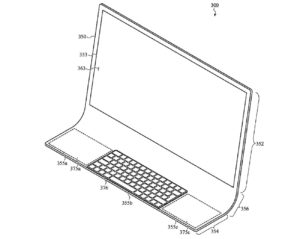The US Patent and Trademark Office (USPTO) has published an application for an unusual design for a new iMac computer.
According to the patent, Apple is considering changing the design of the desktop computer. Apple’s design presents a new vision for a future iMac / desktop PC constructed from a glass housing that includes a continuous surface specified by the upper portion, the lower portion and the portion of the transition.
In the document, Apple describes the “electronic device with a glass case.” The desktop computer is a monolithic piece of glass curving at the bottom.
Apple clarifies that the glass housing could be made of materials that are clear, polished, painted or otherwise handled to create a non-transparent (e.g. opaque) component; in such situations, the material may still be referred to as transparent, even though the material may be part of an opaque component. Translucent components can be produced by creating a textured or frosted surface on a material which is otherwise transparent (e.g., clear glass). Translucent materials, such as translucent polymers, translucent ceramics, or the like, may also be used.
Since the curved part is not enough to support this unusual computer in an upright position, Apple designed the base, which housed the peripheral interfaces and power.
Apple plans to equip such a machine with a system to change the screen angle and even completely close the unit to bring it into sleep mode according to patent documents.
The patent application lists inventors Kate J. Hendren, Paul H. Wang, and several other engineers. Hendren is Apple’s product designer for the Macintosh Architecture Group, who previously worked on embedded capacitive touch sensors for the MacBook. Wang, a design engineer, previously worked on VR and AR devices, as well as the shape-changing Apple Pencil concept.
references:
https://appleinsider.com/articles/20/01/24/apple-working-on-radical-imac-redesign-using-single-sheet-of-glasshttps://www.macrumors.com/2020/01/27/apple-patent-mac-single-sheet-of-glass/https://www.smalltechnews.com/archives/69244




